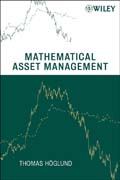
This book serves as an introduction to financial derivatives and portfolio selection, and also acts as a basis for more advanced study of these topics. Thechapter organization is logical, and provides comprehensive, yet concise, coverage of: interest rates; financial instruments that serve as building blocks for portfolios; trading strategies and the importance of estimating the volatility and covariances of returns; stochastic properties of stock prices, the difference between expected return and expected growth (drift), and the geometric Brownian motion; trading strategies with clock time horizon featuring directderivation; diversification featuring optimal portfolios under various constraints; covariation with the market utilizing the Capital Asset Pricing Model; risk and performance measures; and the simplified covariation structure. INDICE: Preface. 1. Interest Rate. 1.1 Flat Rate. 1.1.1 Compound Interest.1.1.2 Present Value. 1.1.3 Cash Streams. 1.1.4 Effective Rate. 1.1.5 Bonds. 1.1.6 The Effective Rate as a Measure of Valuation. 1.2 Dependence on the Maturity Date. 1.2.1 Zero-Coupon Bonds. 1.2.2 Arbitrage Free Cash Streams. 1.2.3 The Arbitrage Theorem. 1.2.4 The Movements of the Interest Rate Curve. 1.2.5 Sensitivity to Change of Rates. 1.2.6 Immunization. 1.3 Notes. 2. Further Financial Instruments. 2.1 Stocks. 2.1.1 Earnings, Interest Rate and Stock Price. 2.2Forwards. 2.3 Options. 2.3.1 European Options. 2.3.2 American Options. 2.3.3 Option Strategies. 2.4 Further Exercises. 2.5 Notes. 3. Trading Strategies. 3.1 Trading Strategies. 3.1.1 Model Assumptions. 3.1.2 Interest Rate. 3.1.3 Exotic Options. 3.2 An Asymptotic Result. 3.2.1 The Model of Cox, Ross and Rubinstein. 3.2.2 An Asymptotic Result. 3.3 Implementing Trading Strategies. 3.3.1 Portfolio Insurance. 4. Stochastic Properties of Stock Prices. 4.1 Growth. 4.1.1The Distribution of the Growth. 4.1.2 Drift and Volatility. 4.1.3 The Stability of the Volatility Estimator. 4.2 Return. 4.3 Covariation. 4.3.1 The Asymptotic Distribution of the Estimated Covariance Matrix. 5. Trading Strategies with Clock Time Horizon. 5.1 Clock Time Horizon. 5.2 Black-Scholes Pricing Formulas. 5.2.1 Sensitivity to Perturbations. 5.2.2 Hedging a Written Call. 5.2.3 Three Options Strategies Again. 5.3 The Black-Scholes Equation. 5.4 Trading Strategies for Several Assets. 5.4.1 An Unsymmetrical Formulation. 5.4.2 A Symmetrical Formulation. 5.4.3 Examples. 5.5 Notes. 6. Diversification. 6.1 Risk and Diversification. 6.1.1 The Minimum-Variance Portfolio. 6.1.2 Stability of the Estimates of the Weights. 6.2 Growth Portfolios. 6.2.1 The Auxiliary Portfolio. 6.2.2 Maximal Drift. 6.2.3 Constraint on Portfolio Volatility. 6.2.4 Constraints on Total Stock Weight. 6.2.5 Constraints on Total Stock Weight and Volatility. 6.2.6 The Efficient Frontier. 6.2.7 Summary. 6.3 Rebalancing. 6.3.1 The Portfolio Development as a Function of the Development of the Stocks. 6.3.2 Empirical Verification. 6.4 Optimal Portfolios with Positive Weights. 6.5 Notes.7. Covariation with the Market. 7.1 Beta. 7.1.1 The Market. 7.1.2 Beta Value.7.2 Portfolios Related to the Market. 7.2.1 The Beta Portfolio. 7.2.2 Stability of the Estimates of the Weights. 7.2.3 Market Neutral Portfolios. 7.3 Capital Asset Pricing Model. 7.3.1 The CAPM-Identity. 7.3.2 Consequences of CAPM. 7.3.3 The Market Portfolio. 7.4 Notes. 8. Performance and Risk measures. 8.1 PerformanceMeasures. 8.2 Risk Measures. 8.2.1 Value at Risk. 8.2.2 Downside Risk. 8.3 Risk Adjustment. 9. Simple Covariation. 9.1 Equal Correlations. 9.1.1 Matrix Calculations. 9.1.2 Optimal Portfolios. 9.1.3 Comparison with the GeneralModel. 9.1.4 Positive Weights. 9.2 Multiplicative Correlations. 9.2.1 Uniqueness of the Parameters. 9.2.2 Matrix Calculations. 9.2.3 Parameter Estimation. 9.2.4 Optimal Portfolios. 9.2.5 Positive Weights. 9.3 Notes. Appendix A: Answers and solutions to exercises. References.
- ISBN: 978-0-470-23287-3
- Editorial: John Wiley & Sons
- Encuadernacion: Cartoné
- Páginas: 222
- Fecha Publicación: 02/05/2008
- Nº Volúmenes: 1
- Idioma: Inglés
